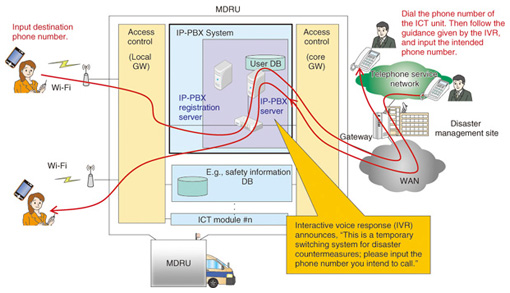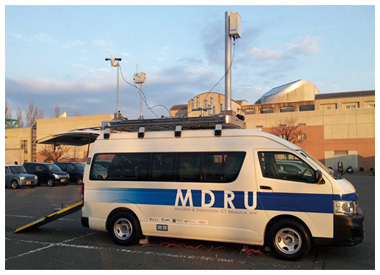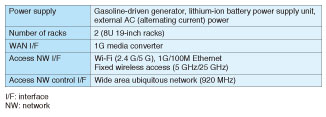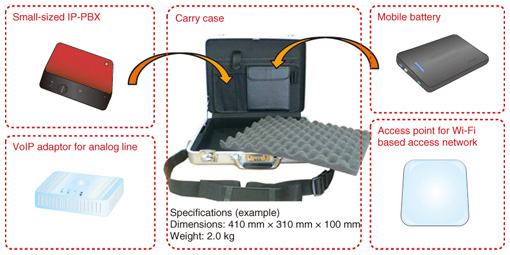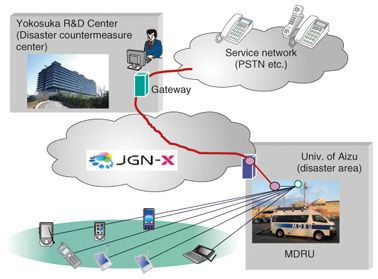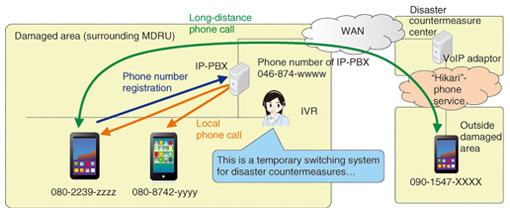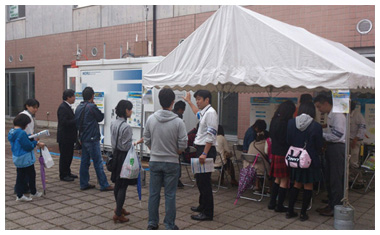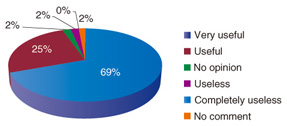 |
|||||||
|
|
|||||||
|
Regular Articles Vol. 12, No. 3, pp. 60–70, Mar. 2014. https://doi.org/10.53829/ntr201403ra1 Rapidly Deployable Phone Service to Counter Catastrophic Loss of Telecommunication FacilitiesAbstractIn this article, we describe a phone service system that enables us to rapidly restore service even when the regular facilities for information and communications technology (ICT) services have been catastrophically damaged in a large-scale disaster. Deploying a movable ICT resource unit with IP-PBX (Internet protocol-based private branch exchange) functionality to the affected areas makes it possible to immediately provide IP phone services using Wi-Fi. Users are able to access phone services using their own smartphones and telephone numbers, which makes the system convenient to use. We developed a prototype system and conducted subjective experiments with users. The results confirmed the effectiveness of the proposed system. Keywords: resilient network, movable ICT-Unit, telephone service 1. IntroductionThe Great East Japan Earthquake and tsunami that struck on March 11, 2011 served as a vivid reminder of the importance of information and communications technology (ICT) networks and services as a social infrastructure. People in disaster-affected areas were not able to use telephone and other ICT services for a long time—from weeks to months—after the event [1]. This situation severely restricted people’s ability to confirm the safety of their family, friends, and relatives, and to check on their assets. There are two main reasons for why this happened. The first is the devastating damage the tsunami caused to the ICT network in the wide northeast coastal region of Japan. The second is the resulting explosive demand for ICT services that occurred in and around the damaged areas. These two factors caused serious traffic congestion and a large gap in the demand and supply of services. Dedicated efforts to restore services by ICT service providers helped to alleviate the situation [2]. However, the number of restored telephone lines was limited and was far short of fulfilling demand, particularly in the early stage of restoration. Reducing the gap between the demand and supply of services was therefore recognized as a critical problem that urgently needs to be solved. We address this issue with our proposed network architecture that improves the resiliency of an ICT network through the use of a movable unit that accommodates resources for providing ICT services in a damaged area [3]. The unit, which we call the movable and deployable ICT resource unit (MDRU), is transported to the damaged area and used to quickly launch ICT services there. By restricting the area the MDRU is used in to local areas, we can provide service again in a very short time. This enables us to reduce the demand/supply gap, particularly in areas where ICT services are most in demand after a disaster. We propose here an IP (Internet protocol) phone service system that is to be added to the MDRU. The proposed system is an extended IP-PBX (private branch exchange) system and is installed in the MDRU. It dramatically simplifies the process of registering customer devices to the PBX. The MDRU provides a Wi-Fi access network. Any user within the service area (500-m radius) of the MDRU can connect their mobile device, for example, a smartphone, to the MDRU over the Wi-Fi access network and register the phone’s number (known by the user and his/her communication partners). With these functions, the proposed system enables us to promptly launch a phone service, which is the service most in demand after a disaster occurs. This article is organized as follows. We present the background that led to our proposed system in section 2. The details of the MDRU features are described in section 3, and the proposed IP phone service system is explained in sections 4 and 5. In section 6, we introduce a prototype of the phone service system along with other systems related to resilient network architecture. A subjective evaluation of the developed prototype and its results are described in section 7. We conclude the article in section 8. 2. Resilient network conceptThe general trend of the demand for ICT services after a disaster is shown in Fig. 1. The horizontal and vertical axes respectively indicate the time and demand for ICT services. As shown in the figure, in the first few days after a disaster occurs, the demand for real-time communications such as telephone and email grows very quickly. This time span is the emergency recovery period, in which people’s primary need for ICT services is to confirm the safety and security of their family, friends, relatives, and assets. Real-time communication in this time period is essential for efficient search and rescue operations and to save the lives of as many victims as possible. The period following this critical stage varies depending on the severity of the disaster. It could range from one week to a year, for example. In this tentative recovery period, people begin working on restoration, and the demand for data communications and processing starts to grow. Victims relocated to shelters need to adjust and make new lives, and the local government needs to support them and offer public services. Information systems are helpful for carrying out these activities smoothly.
In the 2011 disaster, ICT service providers were not able to meet these demands sufficiently. After the disaster, people not only in the damaged area but also in the surrounding areas, including Tokyo, immediately tried to contact friends and family on the phone. This caused severe traffic congestion in the telephone network. Telephone service operators restricted calls to prevent network resources from fatally breaking down. As a result, telephone and other ICT services were paralyzed. Furthermore, the network resources in the disaster area were severely damaged. It took weeks to months to restore them to a normal state. Consequently, one of the lessons learned from the 2011 disaster is that being able to effectively and consistently respond to the demand for services in disaster-stricken areas is a critical issue that urgently needs to be resolved. We have been working to resolve this issue by focusing on the part of the ICT network where traffic congestion occurs. A typical network configuration is shown in Fig. 2. ICT networks usually have a layered structure. The lowest layer is the transport network, which includes communication buildings, optical fibers, and optical networks. Networks for ICT services are constructed by installing service nodes in the buildings and interconnecting the nodes with links provided by the transport network. For instance, a telephone network (or PSTN: public switched telephone network) is formed by installing switching systems in the telecom building and interconnecting them with the links. The Internet is also established by installing and linking routers in the buildings. In this network configuration, the traffic congestion usually occurs at the switching system in the region where calls converge. With telephone traffic, it is very rare for the transport network layer to be the source of traffic congestion. This fact suggests that if calls in the converged area are diverted to a switching system in a vacant area in the transport network layer, the traffic congestion that occurred in the converged area can be reduced.
We took this into account and came up with a concept for improving network resiliency. It involves immediately deploying local services first, then restoring wide area services by linking the local service to an existing proper service node over the transport layer. In the first phase, the time needed to establish service can be reduced by focusing only on the local service restoration, thus meeting the emerging ICT demand just after a disaster. In the second phase, the local service is extended to wide area service without causing traffic congestion. Therefore, this concept is expected to be effective in resolving the aforementioned critical issue. In practical terms, the concept is realized by introducing an MDRU as a hub for deploying local services. The details of the unit are described in the following section. 3. Movable and deployable ICT resource unitAn MDRU is the platform upon which we can realize the concept described in the previous section. A resilient network with an MDRU is shown in Fig. 3. If an ICT network is seriously damaged in a disaster, an MDRU is transported to the damaged area and set up there. The MDRU contains equipment for communication, information processing, and data storage. The MDRU can be driven itself and can also be transported by truck, train, or ship. Once the MDRU is set up in the damaged area, it promptly forms a wireless network to reach the user devices in the surrounding area and then starts delivering ICT services to the local users. After a while, it is connected to a wide area network (WAN) by any available means such as satellite communication links or optical communication links using undamaged optical fibers. An MDRU connected to a WAN acts as a frontline base of ICT services.
The configuration of an MDRU is shown in Fig. 4. It comprises network equipment, an intra-unit network, servers, and storage devices. The network equipment is used for connecting to a WAN and for forming a local area network (LAN). The intra-unit network includes access control servers for WAN and for LAN to enable us to form multiple virtualized intra-unit networks. The servers have software for ICT services such as Voice over IP (VoIP) based PBX, an email server, and other applications. With the resources shown in Fig. 4, MDRU can offer communication functions and information processing and storage functions.
4. IP phone service for disaster reliefPhone service is the ICT service most strongly demanded just after a disaster. People need telephones to confirm the safety and security of their families, friends, relatives, and assets. Local governments also need the service to gather information on the scale of damage, the number of victims, and any other information necessary to plan rescue and restoration activities. Therefore, an IP phone service should be included in the resilient network architecture. 4.1 Features of the proposed IP phone service systemThe proposed IP phone system employs an extended IP-PBX system that is installed in the MDRU. The system has the following features that allow quick and convenient startup of the phone service. At service startup, the user database of the IP-PBX is empty. User data are incrementally added when users first register a device to the IP-PBX using their own phone number. In the PBX systems commonly used in companies, a PBX operation manager prepares the user data and installs it in the user database in the system before service startup. The proposed system enables us to omit this tedious and time-consuming user data preparation process. The second feature is that the system assumes the usage of IP-connectable phone devices and the phone numbers originally provided by the phone service provider and owned by users. If a user wants to use the phone service provided by the proposed system, he/she connects his/her own phone device to the proposed IP-PBX system and registers the device and its regularly used phone number. Once registered, he/she can access the phone service with his/her device and regularly used phone number. The user’s phone device is assumed to be connected to the IP-PBX system in an MDRU via a wired or wireless IP-based network. This feature is related to the characteristics of the MDRU; it can form a Wi-Fi-based IP access network around the MDRU very rapidly. The candidate phone devices are smartphones and personal computers with VoIP software, both of which are rapidly penetrating the market. With this feature, users can quickly connect their phone device to the proposed IP-PBX system. In the descriptions hereafter, we assume a smartphone as the user device. 4.2 System configurationA block diagram of the proposed IP phone system is shown in Fig. 5. The system consists of an IP-PBX server, a registration server, and user devices. The IP-PBX server includes the IP-PBX function and user database. The registration server acts as the interface between the IP-PBX and user devices. It offers information processing for user device registration and control functions for the user database. Each user device has software for IP-PBX registration in which the device’s MAC (media access control) address and its phone number from the SIM (subscriber identity module) card are captured and sent to the registration server through simple user operation. The registration window of a smartphone and the information flow from the smartphone to the user database in the MDRU are shown in Fig. 6. When a user activates the IP-PBX registration software on his/her smartphone, the registration window shown in Fig. 6 is displayed. The window has information input areas for the phone number, user name, and password, which are required for user device registration, and a button for initiating the registration. The phone number is automatically captured from the SIM card embedded in the device and displayed on the window. The user confirms the automatically displayed phone number and inputs his/her username and password, and then taps the button to register. The inputs of the username and password can be omitted in critical situations. Once the user taps the registration button, the information is transmitted to the registration server in the MDRU and input to the user database in the IP-PBX server. Once the user database is updated, the user is ready to use the service with the registered smartphone.
5. Service usageAn illustration of the service in use is shown in Fig. 7. Each user first connects his/her smartphone to the MDRU over the Wi-Fi-based access network. Once a user has connected the smartphone to the MDRU, he/she can use the IP-PBX system to access the described services and to receive incoming calls with the smartphone.
The MDRU service usage has two phases. In the first phase, just after deployment, the MDRU is not connected to any WAN or service network and offers only a Wi-Fi-based access network in the vicinity of the MDRU. In the second phase, the MDRU is connected to the WAN and service networks such as the telephone service network provided by a telecom company. In the first phase, users can use their smartphones to call people in the same affected area. In the second phase, users can call outside the affected area. When someone outside the disaster area wants to call a smartphone registered in the IP-PBX, the person first enters the main phone number of the IP-PBX, then the number of the smartphone as an extension number. Then, smartphones registered in the IP-PBX can receive calls from outside lines. As mentioned above, the proposed service system enables people in disaster-stricken areas not only to make local phone calls promptly after a disaster, but also to make/receive long-distance phone calls in the second phase. 6. Development of a prototype MDRU and testbedWe developed a prototype MDRU to evaluate the feasibility of the proposed concept. The developed MDRU is shown in Fig. 8, and its specifications are listed in Table 1. The prototype is designed to be able to operate the internal equipment for five days without an outside power supply. The target features of the MDRU are listed in Table 2. The ICT services offered are voice, Internet access, and datacenter hosting by a single MDRU that constructs an area within a 500-m radius of the LAN. The phone service system proposed in this article and shown in Fig. 5 was also developed and installed in the MDRU. The phone service accommodates 5000 users. This capacity is extendable by connecting multiple MDRUs. Users access the MDRU using commercially available devices with Wi-Fi or Ethernet connectivity, for example, smartphones and personal computers. The ICT services provided by an MDRU in a disaster situation are restricted to local services in the first phase. Expansion to broad area services is achieved by connecting the MDRU to a WAN using undamaged optical fibers and/or satellite communication links. These capabilities of the MDRU will contribute to meeting the needs and expectations of people in the damaged area.
We also developed a prototype of a portable MDRU in which a function necessary for a specific service has been modularized to improve portability. The portable MDRU, in which we modularized the function for our proposed IP phone service system, is shown in Fig. 9. The portable MDRU comprises a small IP-PBX, mobile battery, Wi-Fi access point, and a VoIP adapter, and is carried in a carry case. We conducted an experiment and confirmed that the portable MDRU was able to operate for 5 hours, during which 140 calls were placed, by using an 18,000-mAh mobile battery. The offered service and ICT resources are limited with this device, but the portability is improved by modularizing it.
We also constructed a testbed in order to simulate deployment of the MDRU after a disaster. An overview of the testbed is shown in Fig. 10. The prototype was deployed on a campus of the University of Aizu in Fukushima. It was connected to NTT’s Yokosuka R&D (research and development) Center through the JGN-X (Japan Gigabit Network-eXtreme) experimental network. This R&D center has a gateway to feed the line into the existing service network. In the testbed, we connected the line to NTT’s FLET’s HIKARI DENWA phone service.
7. Subjective evaluation experimentWe conducted a subjective evaluation experiment using the testbed (Fig. 11). Once the MDRU is activated, the phone service starts. Users who have smartphones register their smartphones to the user database using the pre-installed IP-PBX registration software. After registration, users can make local phone calls to registered smartphones. In the second phase, the MDRU was connected to the WAN through NTT’s Yokosuka R&D Center. With this experimental setup, users in the test area could make long-distance calls. The main phone number of the IP-PBX system is written as 046-874-wwww in Fig. 11. A person dialing this number would hear the message: “This is a temporary switching system for a disaster countermeasure; please input the phone number of the telephone you intend to call.” The user then inputs the desired phone number and reaches the telephone with the IP-PBX system.
We used the above setup to conduct a subjective evaluation experiment of the phone service with the cooperation of the University of Aizu during a campus festival held in October 2013. A photograph of this event is shown in Fig. 12. About 300 men and women ranging in age from their teens to their 70s participated in the experiment. They were asked to evaluate the service’s effectiveness on a 5-level scale. The results of the subjective evaluation are shown in Fig. 13. More than 95% of evaluators ranked the service as useful or very useful.
8. ConclusionWe proposed an emergency phone service system based on an extended IP-PBX. The system is installed on an MDRU that is transported to a damaged area after a disaster occurs. We greatly simplified the process of registering customer devices to the IP-PBX. A Wi-Fi based access network is formed to connect user devices to the IP-PBX. The proposed system can establish a local phone service once the MDRU is powered up in the damaged area. A prototype system was developed, and a subjective evaluation was performed. The evaluation results confirmed the effectiveness and feasibility of our proposed system. AcknowledgementThis work is partly supported by the R&D project on “ICT Projects for resilient information and communication networks” and on “the movable ICT-Units for emergency transportation into disaster-affected areas and multi-unit connection,” both by the Ministry of Internal Affairs and Communications (MIC) of Japan. The authors would like to express their appreciation to the project members from Tohoku University and Fujitsu Corporation for their collaborative work. References
|
|||||||







